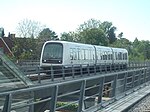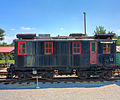Portals → Technology → Transport → Trains
The trains portal
|
In rail transport, a train is a vehicle or (more frequently) a string of vehicles capable of being moved along a continuous line of rails or other guideway for the purpose of conveying freight or passengers between points on a predetermined route. The train may be hauled or propelled by one or more vehicles designed exclusively for that purpose (locomotives) or may be driven by a number of motors incorporated in all or several of the vehicles (multiple units). As of 2018, there are approximately 1,052,000 kilometres (654,000 mi) of railway track in use worldwide. (World Bank (via Archive.org)) |
|
Selected article of the week
The AnsaldoBreda Driverless Metro is a class of driverless electric multiple units and corresponding signaling system. Manufactured by AnsaldoBreda of Italy, it is or will be used on the Copenhagen Metro, the Brescia Metrobus, the Thessaloniki Metro, Line C of the Rome Metro, Line 5 of the Milan Metro and the Yellow Line of the Taipei Rapid Transit System. The first system to take the class into use was Copenhagen, which opened in 2002. The next systems are under construction and will open in 2011 and 2012. The rolling stock consists of three to six articulated cars, making the trains 39 to 109 meters (128 to 358 ft) long. All but one system is 2.65 meters (8.7 ft) wide, and all use standard gauge. Each car has a power output of 210 or 256 kilowatts (282 or 343 hp), fed from a third rail at 750 volts (except in Rome). The systems are fully automated, consisting of automatic train protection (ATP), automatic train operation (ATO) and automatic train supervision.
Recently selected: Milwaukee Airport Railroad Station - Sognsvann Line - South Kensington tube station
Selected image of the week
Transloading coal from railroad hopper cars to ships involved first getting the coal out of the hoppers and then transferring it onto the ships. Here, the hopper cars are pushed up a short incline by a car pusher where the cars' bottom doors are opened and the coal is emptied by gravity. The coal is then carried up the structure, in this case in bucketloads via an elevator system, and loaded onto the ships.
Recently selected: JNR Type 151 - Deutsche Reichsbahn freight train - FEVE
Did you know...
- ...that the opening ceremonies of the Galway to Clifden railway were very sparsely attended because the event date was a strict church holiday and was reserved for attending church services?
- ...that following heavy damage to the Galveston Island Trolley track and cars from Hurricane Ike in 2008, substitute service with replica buses was operated until service resumed in October 2021?
- ...that although the former Santa Fe Railway's Galesburg station was demolished after regular passenger service to the station ended in 1996, the site is still used if derailments cause trains to use the Chillicothe Subdivision instead of the Mendota Subdivision?
- ...that the Fuzhou–Xiamen railway, which opened in 2010, was so heavily used that it reached capacity in 2015, spurring construction on the parallel Fuzhou–Xiamen high-speed railway for CRH passenger train services?
Selected anniversaries
- August 9
- 1805 – Joseph Locke (pictured), English civil engineer who became Chief Engineer on the Grand Junction Railway, is born (d. 1860).
- 1844 – In the United Kingdom, the Railway Regulation Act of 1844 requires every railway company to run at least one passenger train a day in both directions along the length of each of its lines, calling at every station; these trains soon become known as Parliamentaries.
- 1958 – The Moccasin, the longest running named passenger train in Canada thus far, is discontinued.
- 2003 – Indian Railways begins passenger train service between Hyderabad and Secunderabad with 13 trains between Lingampally and Hyderabad, and 11 between Lingampally and Secunderabad. Also see Hyderabad MMTS
Train News
- July 24, 2021 – Atchison, Topeka and Santa Fe No. 2926, a 4-8-4 steam locomotive built by Baldwin Locomotive Works in 1944, moves under its own power for the first time since Christmas Eve of 1953, after nearly twenty-two years of being rebuilt by volunteers. The locomotive will be put into mainline excursion service. (NMSL&RHS, Trains Magazine on Facebook)
- May 5, 2021 – Steamtown National Historic Site completes thorough cosmetic overhaul on Union Pacific 4-8-8-4 Big Boy No. 4012, which is moved back on static display before National Train Day. (NEPA Scene)
- April 2, 2021 – 2021 Hualien train derailment – A Taroko Express train operated by the Taiwan Railways Administration (TRA) derails at the north entrance of Qingshui Tunnel in Heren Section, Xiulin Township, Hualien County, Taiwan, killing 49 people and injuring at least 200 others. North of Hualien City a construction truck had fallen down a slope onto the tracks. The eight-carriage train derailed after colliding with the truck, and then came to a rest in the tunnel, with severe damage and many casualties. (Bloomberg, CNN, CNA, New York Times, Financial Times)
- December 31, 2020 – Following a complete restoration, Chesapeake and Ohio 1309, a 2-6-6-2 Mallet locomotive built by Baldwin Locomotive Works in 1949, the last steam locomotive built by Baldwin for the North American market, is operated under its own power for test runs. When returned to service on the Western Maryland Scenic Railroad, it will be the largest steam locomotive in regular scheduled service in the United States and take 2-8-0 No. 734’s place as the largest active steam locomotive in the state of Maryland. (Trains.com Newswire)
- September 28, 2020 – Amtrak operates a test run using one of the 28 new Avelia Liberty trains manufactured by Alstom along the full length of the Northeast Corridor to Boston South Station. Previous test runs had occurred from Washington, D.C., only as far north as New Jersey and Delaware. Barring any problems, the trains are expected to enter regular service on the route in 2021. (Universal Hub)
- June 13, 2020 – The Bay Area Rapid Transit Silicon Valley BART extension opened its stations in Milpitas and North San Jose. (San Jose Spotlight, SF Gate)
General images
WikiProjects
WikiProject Trains (Shortcut: WP:TWP)
- WikiProject Stations (WP:STA)
- WikiProject Streetcars (WP:TRAM)
- WikiProject Rapid transit (WP:RTPJ) inactive
- By region:
- WikiProject Metros of the former Soviet Union (WP:SOVMETRO) inactive
- WikiProject Indian railways (WP:INRW)
- WikiProject Trains in Japan (WP:TJ)
- WikiProject New Zealand Railways (WP:NZR)
- WikiProject Pakistan Railways (WP:PKR) inactive
- United Kingdom
- United States
- Fictional rail transport topics:
Note: WikiProjects marked as inactive are retained pending future editing activity
Subcategories
Things you can do
See also Wikipedia:WikiProject Trains/Todo and Wikipedia:Pages needing attention/Railroads
Associated Wikimedia
The following Wikimedia Foundation sister projects provide more on this subject:
-
 Commons
Commons
Free media repository -
 Wikibooks
Wikibooks
Free textbooks and manuals -
 Wikidata
Wikidata
Free knowledge base -
 Wikinews
Wikinews
Free-content news -
 Wikiquote
Wikiquote
Collection of quotations -
 Wikisource
Wikisource
Free-content library -
 Wikiversity
Wikiversity
Free learning tools -
 Wiktionary
Wiktionary
Dictionary and thesaurus


















































































Recent Comments